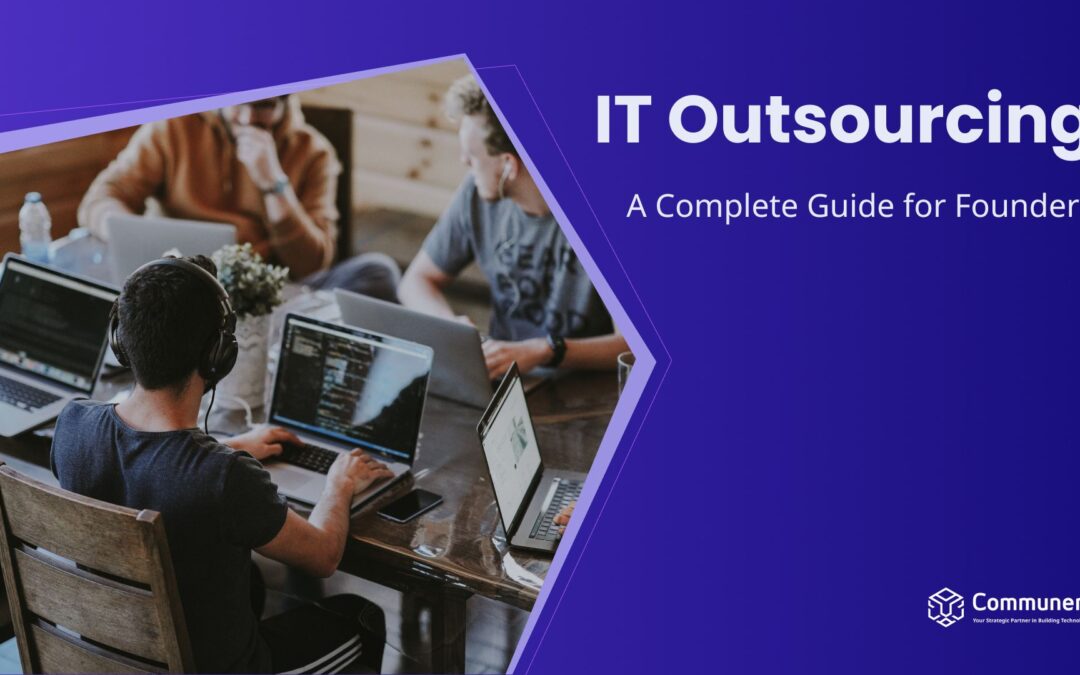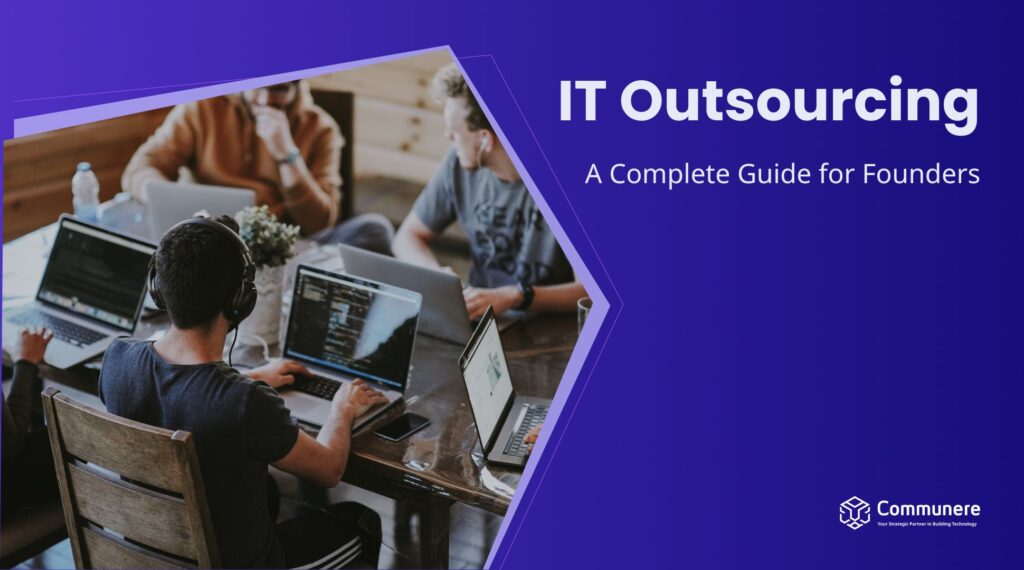The concept of IT outsourcing has burgeoned beyond traditional boundaries, becoming an indispensable facet of modern business strategy, and it’s pivotal to understand the profound implications and transformative potential that IT outsourcing presents.
This blog post delves into the world of IT outsourcing, offering a comprehensive view of its current state, the innovative trends shaping its future, and the strategies businesses can adopt to thrive in this new era.
Table of Contents
- What is IT Outsourcing?
- The Benefits of IT Outsourcing
- The Disadvantages of IT Outsourcing
- Emerging Technologies Reshaping IT Outsourcing
- Business-Driven IT Outsourcing Trends
- Practical Considerations in IT Outsourcing
- Competitive Dynamics and Client Expectations
- Introducing Communere: Pioneering the Future of IT Outsourcing
- Conclusion
What is IT Outsourcing?
In an era where technological advancements occur at a breakneck pace, businesses across the spectrum, from spirited startups to sprawling enterprises, are increasingly turning to IT outsourcing to navigate the complexities of the digital age. This shift is not merely about delegating tasks; it’s about embracing a partnership model that leverages global expertise, fosters innovation, and drives competitiveness in an ever-changing market.
IT outsourcing is a strategic practice that has become integral to modern business operations. It involves contracting out various IT-related tasks or services to external vendors or service providers. This practice enables businesses to achieve multiple objectives, such as reducing costs, accessing specialized expertise, and focusing on core business functions.
The essence of IT outsourcing lies in its flexibility and adaptability to the needs and goals of a business. Companies can outsource an array of IT services, ranging from software development, data storage, and cloud services to cybersecurity and IT infrastructure management. The decision to outsource is often driven by the desire to leverage external expertise, improve efficiency, and optimize resource allocation.
Different Models of IT Outsourcing
- Staff Augmentation: This model involves adding external IT professionals to an existing in-house team on a temporary or project basis. Businesses often use staff augmentation to address short-term skill gaps, manage workload peaks, or bring in specialized skills that are not available internally.
- Project-Based Outsourcing: In this model, an entire project is outsourced to an external service provider who is responsible for delivering the project within agreed parameters such as scope, time, and budget. This approach is commonly used for specific, well-defined projects.
- Managed IT Services: This involves outsourcing the management of certain IT functions or infrastructure to a third-party provider. The provider takes on the responsibility of ensuring the smooth operation of IT services, often under a long-term contract. Managed services cover a wide range of areas, including network management, helpdesk services, and cybersecurity.
- Offshore Outsourcing: This model involves outsourcing IT services to a provider in another country. Offshore outsourcing is often chosen for its cost benefits, as businesses can take advantage of lower labor costs in other regions while accessing a global talent pool.
- Nearshore Outsourcing: Similar to offshore outsourcing, nearshore outsourcing involves contracting IT services to providers in neighboring or nearby countries. This model offers cultural and time zone advantages, making collaboration more streamlined than with far-offshore providers.
- Cloud Services Outsourcing: With the rise of cloud computing, many businesses opt to outsource their data storage, processing, and management needs to cloud service providers. This approach offers scalability, flexibility, and cost savings, as businesses can pay for only what they use.
The choice of a particular model depends on factors like the specific needs of the business, the nature of the IT tasks, budget constraints, and the desired level of control over the outsourced functions. By understanding these models, businesses can make informed decisions that align with their strategic goals and operational requirements.
The Benefits of IT Outsourcing
IT outsourcing presents a trio of compelling advantages: cost-effectiveness, access to global talent, and the ability to focus on core business functions. These benefits collectively contribute to enhanced operational efficiency, greater competitive advantage, and improved business outcomes.
Cost-Effectiveness
Outsourcing IT services can lead to significant financial savings for businesses. This cost-effectiveness arises from several factors. Firstly, outsourcing eliminates the need for substantial capital investments in IT infrastructure, as external providers already have the necessary technology and systems in place. This shift from a capital expenditure model to an operational expenditure model allows for better budget control and reduced financial risk.
Additionally, outsourcing can reduce labor costs. Hiring and maintaining an in-house IT team entails not just salaries, but also benefits, training, and other associated expenses. By outsourcing, companies can access the same level of expertise without these overheads. Moreover, the competitive nature of the global outsourcing market often means that services can be procured at a more economical rate, especially when outsourcing to regions with lower labor costs.
Access to Global Talent
IT outsourcing opens the door to a vast global talent pool, enabling businesses to tap into a wide array of skills and expertise that may not be readily available locally. This access is particularly beneficial in the technology sector, where the pace of change is rapid, and the demand for specialized skills is high.
With outsourcing, companies are not limited by geographic constraints and can find the best fit for their IT needs, whether that’s niche technical expertise, innovative development methodologies, or cutting-edge technological know-how. This global reach not only enhances the quality of IT services but also provides businesses with a competitive edge in adopting and leveraging new technologies.
Focus on Core Business Functions
Outsourcing IT services allows companies to concentrate on their core competencies and business functions. In today’s competitive business environment, it’s crucial for companies to optimize their resources and focus on areas that offer the most value and differentiation in the market. By outsourcing IT functions, businesses can redirect their internal resources and attention toward strategic initiatives that drive growth and innovation.
This focus is particularly beneficial for small and medium-sized businesses, which might not have the resources to maintain a comprehensive in-house IT department. Outsourcing provides them with access to high-quality IT services, enabling them to compete on a level playing field with larger corporations. For larger enterprises, it allows them to streamline their operations and focus on core areas of expertise, while external experts handle the IT aspects.
Read more: Major Benefits of Outsourcing Software Development
The Disadvantages of IT Outsourcing
As with any evolving domain, IT outsourcing is not without its challenges and controversies. Issues such as cultural compatibility, time zone differences, and balancing cost with quality are at the forefront of discussions. Addressing these concerns is crucial for businesses to harness the full potential of IT outsourcing
Risk of Cultural Incompatibility
Working with IT service providers from different cultural backgrounds can pose significant challenges. Cultural incompatibility can manifest in various ways, from communication barriers to differing work ethics and business practices. For instance, in some cultures, there is a reluctance to say ‘no’ or express disagreement directly, which can lead to misunderstandings and unmet expectations.
This cultural gap can affect several aspects of a project, including teamwork, meeting deadlines, and the overall quality of the output. To mitigate these risks, businesses should invest time in understanding the cultural norms and communication styles of their outsourcing partners. Building a relationship based on mutual respect and clear communication can help bridge cultural differences and ensure smoother project execution.
Loss of Some Control
Outsourcing IT functions often means ceding some degree of control over those aspects of the business. While this can free up resources and allow a company to focus on core areas, it can also lead to concerns about the quality and timeliness of the work being outsourced.
Companies might find it challenging to oversee day-to-day operations and ensure that the outsourced work aligns with their business objectives and standards. To address this, it’s crucial to establish clear communication channels, set well-defined goals and expectations, and engage in regular monitoring and reporting. Choosing the right outsourcing partner, one that understands and aligns with your business values and goals is also critical in minimizing this disadvantage.
Time Zone Differences
Outsourcing to a provider in a different time zone can complicate communication and project coordination. This can lead to delays in responses, challenges in scheduling meetings, and potential issues with meeting project deadlines. These time zone differences can affect the agility and responsiveness of a business, which is particularly crucial in industries where quick decision-making is key.
To mitigate these challenges, businesses can implement strategies such as establishing overlapping working hours, using asynchronous communication tools effectively, and possibly even rotating meeting times to accommodate different time zones. Advanced planning and clear communication protocols can help ensure that projects stay on track despite the geographical distance.
Emerging Technologies Reshaping IT Outsourcing
Emerging technologies are profoundly reshaping the landscape of IT outsourcing, introducing new capabilities, and changing the way outsourcing services are delivered and managed. These advancements are not only enhancing the quality and efficiency of services but also opening up new opportunities for businesses to innovate and grow. Here’s a look at some key technologies that are currently transforming the IT outsourcing industry:
- Generative AI (GenAI): Generative AI has seen rapid growth and is significantly impacting IT recruiting trends. Companies are increasingly seeking engineers skilled in Java, R, and Python to integrate AI tools like ChatGPT, Bing Chat, and Jasper into their tech stacks. The integration of Natural Language Processing capabilities and image recognition through tools like PyTorch and TensorFlow is enhancing user interactions and enabling sophisticated applications like deep fake detection and medical data augmentation.
- Continuous Threat Exposure Management (CTEM): In response to evolving cyber threats, CTEM is emerging as a crucial strategy. This integrated, iterative approach identifies, assesses, and manages cybersecurity threats and vulnerabilities. Companies are seeking outsourcing partners with skills in cybersecurity tools and apps, data analytics, programming and scripting languages, risk assessment and management, and incident response protocols.
- Internet of Behavior (IoB): An evolution of the Internet of Things (IoT), the IoB combines data analysis, behavioral study, and human psychology to understand and predict behavior patterns and personalize user experiences. This requires teams skilled in IoT software development, data science, programming, UX, and privacy/security principles.
- Low Code Development Platforms (LCDP): LCDPs are facilitating the efficiency of niche outsourcing services by allowing businesses to develop tailored solutions with reduced development times. This trend is enhancing the speed and agility of software development, enabling businesses to adapt quickly to changing needs.
- Integration of AI-Driven Technologies: AI-driven technologies, including automated code testing and development automation, are optimizing processes and contributing to the sophistication of tailor-made outsourcing solutions. This integration is reshaping the outsourcing landscape by enabling more efficient and advanced service offerings.
- Blockchain Integration for Enhanced Security: Blockchain technology is being increasingly used in outsourcing to ensure secure and transparent transactions. Its decentralized nature adds an extra layer of security to data and financial transactions, thereby transforming how outsourcing agreements are executed and managed.
Business-Driven IT Outsourcing Trends
The business-driven trends in IT outsourcing are undergoing a significant transformation. We are witnessing a shift towards hybrid outsourcing models, greater integration of blockchain technology for enhanced security, and a heightened focus on upskilling initiatives for outsourced teams. These trends are indicative of a broader move towards more sophisticated, secure, and effective outsourcing strategies. Here are some key trends currently influencing the IT outsourcing industry:
- Hybrid Outsourcing and Flexible Business Models: There’s a growing preference for hybrid outsourcing models, especially among businesses of various ages and sizes. Mature businesses and newer enterprises are showing distinct preferences in their outsourcing approaches. This trend indicates a shift towards more flexible and customized outsourcing solutions that can cater to specific business needs and objectives.
- Managed Security Service Providers (MSSP): With the increasing complexity of cybersecurity threats, businesses are turning to MSSPs to augment or replace their internal security teams. This trend is driven by the need for specialized expertise, round-the-clock protection, and cost-effective security solutions. MSSPs provide a range of services, including intrusion detection and prevention, role-based access control, and threat search, enabling businesses to enhance their security posture without incurring the high costs of maintaining an in-house team.
- The Internet of Things (IoT) in Outsourcing: The growing number of devices connected to the IoT is creating new demands for external expertise in IoT technology. Many companies lack the necessary skills to manage this technology, leading to an increased demand for outsourcing services specializing in IoT. This trend is being driven by applications in security, agriculture, waste management, and other sectors where IoT can automate feedback and data collection.
- Low Code Development Platforms (LCDP): The adoption of LCDPs is contributing to the efficiency of niche outsourcing services. These platforms enable businesses to develop custom solutions quickly, thereby adapting faster to evolving business needs. This trend is particularly significant in the context of rapid technological changes and the need for agile business responses.
- Blockchain for Outsourcing Transactions: Blockchain technology is increasingly being integrated into outsourcing processes, particularly for ensuring secure and transparent transactions. The decentralized nature of blockchain provides an added layer of security and integrity to outsourcing agreements, making them more resilient against data tampering and fraudulent activities.
- Upskilling Initiatives for Outsourced Teams: There is a growing focus on continuous learning and development within outsourced teams. This trend acknowledges the importance of keeping skills up to date in a rapidly changing tech environment, ensuring that outsourced teams can provide high-quality, innovative solutions that align with current market demands.
- Scalability and Security in Web Development: Outsourcing IT solutions are increasingly focused on scalability and advanced security measures. Companies are looking to outsource partners who can provide scalable solutions that accommodate future expansion and improvements, as well as robust security protocols to protect against breaches and cyber threats.
Read more: How to Outsource Software Development
Practical Considerations in IT Outsourcing
There are several practical considerations that businesses need to account for to ensure successful and efficient collaborations. These considerations encompass various aspects of the outsourcing process, from the initial selection of a service provider to the ongoing management of the outsourcing relationship. Here’s a detailed look at some of these key considerations:
- Choosing the Right Outsourcing Partner: The selection of an outsourcing partner is a critical decision. Businesses should conduct thorough due diligence to assess potential partners’ expertise, track record, and compatibility with their specific needs and organizational culture. This includes reviewing portfolios, seeking references, and evaluating communication skills and responsiveness.
- Defined Goals and Expectations: Setting clear, achievable goals and expectations is essential for the success of any outsourcing relationship. This involves defining project scopes, deliverables, timelines, and quality standards upfront. Having a well-articulated agreement can help prevent misunderstandings and ensure that both parties are aligned in their objectives.
- Effective Communication and Collaboration: Maintaining open and effective communication channels is crucial for managing outsourcing relationships. Regular updates, feedback sessions, and proactive problem-solving can help keep projects on track and build a strong working relationship with the outsourcing provider. Utilizing collaboration tools and platforms can facilitate smoother interaction, especially when dealing with offshore teams.
- Managing Risks and Security Concerns: When outsourcing IT functions, it’s important to consider the associated risks, particularly concerning data security and intellectual property protection. Businesses should ensure that their outsourcing partners adhere to robust security protocols and comply with relevant data protection regulations. Risk management strategies should be in place to address potential security breaches or data loss scenarios.
- Cultural Compatibility and Time Zone Differences: Cultural differences and time zone disparities can pose challenges in outsourced projects. Businesses should strive to understand and respect the cultural nuances of their outsourcing partners and find ways to work effectively across different time zones. This might include scheduling regular meetings at mutually convenient times and being mindful of cultural holidays and working hours.
- Quality Control and Project Management: Implementing strong quality control and project management processes is key to ensuring that outsourced work meets the desired standards. Regular monitoring, testing, and reviews should be part of the project lifecycle to catch and address issues early. Businesses may also consider using project management tools to track progress and maintain oversight.
- Flexibility and Scalability: The outsourcing arrangement should be flexible enough to accommodate changing business needs and scalable to handle varying project sizes or demands. This flexibility can be particularly valuable in rapidly evolving industries or in response to market changes.
- Exit Strategy and Transition Planning: Finally, having a well-defined exit strategy and transition plan is important for any outsourcing arrangement. This ensures that businesses can smoothly transition services back in-house or to another provider if needed, without disruption to their operations.
Read more: Important Outsourcing Software Development Pros and Cons
Competitive Dynamics and Client Expectations
In the realm of IT outsourcing, the competitive dynamics and client expectations are constantly evolving, influenced by various factors including technological advancements, market trends, and changing business needs. Understanding these aspects is crucial for both service providers and clients to foster successful partnerships and achieve desired outcomes. Here’s an overview of the current competitive dynamics and client expectations in IT outsourcing:
- Outcome-Based Contracts and Collaboration: There is a growing trend towards outcome-based contracts in IT outsourcing. This approach focuses on the results delivered rather than just the services provided. Such contracts often involve more collaboration between the client and the outsourcing provider, with an emphasis on shared risks and rewards. This trend is leading to a more partnership-oriented approach, where both parties work closely to achieve common goals.
- Client Expectations for High-Quality Solutions: Modern clients seeking IT outsourcing services demand high-quality solutions that are not only cost-effective but also align with the latest technological advancements. There is an increasing expectation for providers to be flexible, innovative, and in sync with cutting-edge technologies. This shift is partly due to the rapidly changing technology landscape and the need for businesses to stay competitive.
- Increased Competition Among Providers: The IT outsourcing market is becoming more competitive, with providers vying for significant deals and offering innovative solutions to attract clients. This competition can lead to better services and more competitive pricing for clients, but it also means that providers must continuously improve and differentiate their offerings to stand out in the market.
- Client-Centric Approaches: Outsourcing companies are increasingly adopting a customer-centric approach, focusing on understanding and meeting the specific needs of their clients. This trend is a response to the growing dissatisfaction among clients with providers who are perceived as inflexible or out of touch with their needs. A client-centric model emphasizes personalized service, responsiveness, and tailored solutions.
- Transparency and Trust: Clients now expect a higher degree of transparency and trust from their outsourcing partners. This includes clear communication, honest reporting, and a collaborative approach to problem-solving. Establishing trust and maintaining transparency are essential for long-term partnerships and successful project outcomes.
- Adapting to New Technologies and Data Security: With the rapid advancement of technologies like AI, blockchain, and IoT, clients expect their outsourcing partners to be well-versed in these areas. Additionally, with increasing concerns about data privacy and security, providers must demonstrate their capability to secure data and comply with relevant regulations.
Read more: Nearshore Software Development: A Complete Business Guide
Introducing Communere: Pioneering the Future of IT Outsourcing
At Communere, we understand that the digital age demands more than just conventional solutions. It requires a blend of innovation, agility, and a deep understanding of the unique challenges and aspirations that each business faces. Our journey began with a commitment to not just participate in the IT industry but to redefine it. We identified a gap in the market for a service that transcends traditional software development paradigms and addresses the specific needs of a diverse client base. This insight led to the birth of Communere – a company that doesn’t just create software but crafts bespoke digital experiences that are at the forefront of technological advancement.
What sets Communere apart in the bustling domain of software development is our unique value proposition. Unlike many companies that focus solely on the technical aspects of software development, we delve deeper. We see ourselves as matchmakers in the realm of software development, connecting clients with the crème de la crème of global software development talent. We are facilitators of innovation and enablers of digital transformation.
What Makes Communere Unique?
- Matchmaking in Software Development: Communere distinguishes itself by transcending the traditional boundaries of software development. The company prides itself on connecting clients with world-class software development talent. This unique matchmaking approach often leads to misconceptions about Communere being a mere recruitment agency, but their services extend far beyond, offering comprehensive and integrated software development solutions.
- Cost-Effective Development Solutions: In a market where the cost of software development can be prohibitively high, Communere provides a breath of fresh air. The company enables clients to achieve their software development goals without the burden of a hefty price tag. This is achieved through the introduction of top-notch offshore software developers, ensuring projects remain budget-friendly while clients maintain full ownership and control.
- Comprehensive Support: Contrasting the traditional hiring processes, which can be costly and lacking in support, Communere offers a solution that ensures cost-effectiveness, control, and ongoing support throughout the development lifecycle. This approach addresses the common challenges in software development outsourcing, such as hidden costs and concerns over ownership rights.
Addressing Challenges in IT Outsourcing
Communere recognizes and actively addresses the prevalent challenges in software outsourcing. Their focus is on delivering high-quality software solutions while ensuring affordability and maintaining client control over projects. This approach involves:
- Quality Assurance: Prioritizing the delivery of high-quality software solutions.
- Affordability: Striking a balance between reducing costs and not compromising on talent or output quality.
- Client Control: Ensuring that clients retain full control over their projects.
A Unique IT Outsourcing Approach
- Flexible Team Integration: Communere offers the flexibility of integrating a few developers or a dedicated team that collaborates closely with clients. This approach functions as an extension of the client’s internal team, ensuring seamless project execution.
- Cost Savings and Global Talent Access: Clients benefit from significant cost savings, potentially up to 70%, while accessing a global pool of IT talent.
- Client-Centric Model: Communere’s model is designed to ensure that clients retain full control over their projects, meet targets and deadlines, and prioritize effective communication for a seamless solution build.
At the heart of Communere’s philosophy is a commitment to changing industry perspectives through innovative approaches. By balancing the needs for quality, cost-efficiency, and control, Communere aims to position itself as the ideal strategic tech partner for a diverse range of software development needs.
We’re a pioneering force in the IT outsourcing industry, offering unique solutions that blend cost-effectiveness, quality, and client-centric approaches, all while addressing the evolving challenges and needs of the digital age.
Conclusion
IT outsourcing is undergoing significant transformations, influenced by emerging technologies and shifting business strategies. The integration of advanced technologies such as Generative AI, CTEM, IoB, Low Code Development Platforms, and Blockchain is not only enhancing the capabilities of outsourcing services but also redefining the skillsets and expertise required in the industry.
Business-driven trends like hybrid outsourcing models, the rise of MSSPs, the growing importance of IoT, and client-centric approaches are reshaping the way companies engage with outsourcing providers. These trends highlight the need for flexibility, innovation, and a focus on delivering high-quality, tailored solutions.
On the practical front, considerations such as choosing the right partner, effective communication, managing risks, and ensuring cultural compatibility and flexibility remain paramount. These factors play a crucial role in the success of outsourcing endeavors and in fostering strong, mutually beneficial partnerships.
Moreover, the competitive dynamics in the IT outsourcing market underscore the importance of outcome-based contracts, high-quality solutions, and a customer-centric approach. Providers that can adapt to these changes and meet the evolving expectations of clients are more likely to thrive in this competitive landscape.
In conclusion, IT outsourcing in 2024 presents a complex yet exciting array of opportunities and challenges. For businesses looking to leverage these trends, the key lies in staying informed, being adaptable, and choosing outsourcing partners who not only align with their technological needs but also share their vision and values. As the industry continues to evolve, those who can effectively navigate these changes will be well-positioned to harness the full potential of IT outsourcing for growth and innovation.




![Why Custom Web Development is the Best Approach [2024]](https://resources.communere.com/wp-content/uploads/2024/02/Why-Custom-Web-Development-is-the-Best-Approach-1024x570.jpg)

